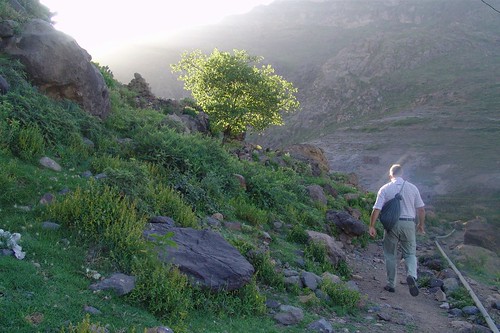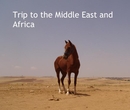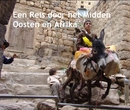Three days away in the mountains
Three days away with a driver (Fouad) and his Toyota Land Cruiser.
To the Hazra Mountains to the south-west of Sanaa, passing over the highest mountain in Arabia at 3,600 or almost 12,000 feet (the road going quite near the summit).
Then down towards the coast and up in a northerly direction through Wadi Sara, tropically hot and humid, with banana trees, the 60 km road going along the river bed.
Then back up to a long string of mountains with peaks of 2,400 to 2,800 metres, passing through numerous hill towns and villages, notably al-Mahwit, the White City.
Then on into a different terrain, with high plateaus dropping off to high plains, around the towns of Kawkaban, Shiban and Thula, about 80 kms north-north west of Sanaa.
In between, we went on some long(ish) hikes up, down and around the mountains, usually starting at 7 am, after an early start for sunrise and breakfast. So beautiful, in the cool fresh clear morning air, new vistas continually coming into view... a hill-top village, a wide bank of terraces, a well with livestock, flowers, birds soaring on the breeze.
What we have seen has been amazing: green terraces, filled with maize, wheat, qat trees, tomatoes, potatoes and centuries old, ancient hillside villages, built of stone, the houses mostly built high, with very few windows, all close together for defensive purposes, old carved wooden doors, (with doorways only about 4 feet high (such that I have banged my head about 5 times and Fred two, both of our heads being a complete mess), a 'lost' Jewish village, beautiful flowers, many many birds including eagles, vultures, kites, crows, bee-eaters, wheatears, meadow larks, orange-winged blackbirds, waders, hummingbirds and even a large hornbill and numerous unidentified others, camels, donkeys, goats, sheep, cows and bulls, livestock markets, Yemeni women at work in the fields, bringing in hay, collecting water, looking after the children and the livestock, always covered, Yemeni men chewing qat and chewing some more qat, Yemeni children, some going to school and some helping with the animals.
A pretty intense three days with plenty of exposure to Yemeni culture. Such as the Mafraj, the large room at the top of the tall houses, laid out with divans, cushions and blankets where men will sit around and chew qat (and where foreign visitors will be welcomed). The women will work somewhere below, in the kitchen or with the children and the ground floor will normally be reserved for livestock.... such that even in the larger towns, one will be surprised to find a proud man feeding his bull.
We saw plenty of Jambias, the knives worn by the men around their wastes. Some very beautiful, all striking. In some places they would carry around a Kalashnikov and at times, we would here these beiung fired, when excited, such as at a wedding party.
We would hear about blood feuds with tribes playing tit-for-tat killings to avenge a wrong-doing by another tribe... not stopped until 25 had been killed.
But most of all, we experienced fantastic hospitality and friendliness of the Yemeni, it being very easy to strike up conversations (only with the men) (The best thing you can do to a woman is to completely ignore her even if she has just cooked you a tremendous meal - but that is a story for another day. Now time for bed.
To the Hazra Mountains to the south-west of Sanaa, passing over the highest mountain in Arabia at 3,600 or almost 12,000 feet (the road going quite near the summit).
Then down towards the coast and up in a northerly direction through Wadi Sara, tropically hot and humid, with banana trees, the 60 km road going along the river bed.
Then back up to a long string of mountains with peaks of 2,400 to 2,800 metres, passing through numerous hill towns and villages, notably al-Mahwit, the White City.
Then on into a different terrain, with high plateaus dropping off to high plains, around the towns of Kawkaban, Shiban and Thula, about 80 kms north-north west of Sanaa.
In between, we went on some long(ish) hikes up, down and around the mountains, usually starting at 7 am, after an early start for sunrise and breakfast. So beautiful, in the cool fresh clear morning air, new vistas continually coming into view... a hill-top village, a wide bank of terraces, a well with livestock, flowers, birds soaring on the breeze.
What we have seen has been amazing: green terraces, filled with maize, wheat, qat trees, tomatoes, potatoes and centuries old, ancient hillside villages, built of stone, the houses mostly built high, with very few windows, all close together for defensive purposes, old carved wooden doors, (with doorways only about 4 feet high (such that I have banged my head about 5 times and Fred two, both of our heads being a complete mess), a 'lost' Jewish village, beautiful flowers, many many birds including eagles, vultures, kites, crows, bee-eaters, wheatears, meadow larks, orange-winged blackbirds, waders, hummingbirds and even a large hornbill and numerous unidentified others, camels, donkeys, goats, sheep, cows and bulls, livestock markets, Yemeni women at work in the fields, bringing in hay, collecting water, looking after the children and the livestock, always covered, Yemeni men chewing qat and chewing some more qat, Yemeni children, some going to school and some helping with the animals.
A pretty intense three days with plenty of exposure to Yemeni culture. Such as the Mafraj, the large room at the top of the tall houses, laid out with divans, cushions and blankets where men will sit around and chew qat (and where foreign visitors will be welcomed). The women will work somewhere below, in the kitchen or with the children and the ground floor will normally be reserved for livestock.... such that even in the larger towns, one will be surprised to find a proud man feeding his bull.
We saw plenty of Jambias, the knives worn by the men around their wastes. Some very beautiful, all striking. In some places they would carry around a Kalashnikov and at times, we would here these beiung fired, when excited, such as at a wedding party.
We would hear about blood feuds with tribes playing tit-for-tat killings to avenge a wrong-doing by another tribe... not stopped until 25 had been killed.
But most of all, we experienced fantastic hospitality and friendliness of the Yemeni, it being very easy to strike up conversations (only with the men) (The best thing you can do to a woman is to completely ignore her even if she has just cooked you a tremendous meal - but that is a story for another day. Now time for bed.
Labels: Trip to Middle East and Africa, Yemen





2 Comments:
This comment has been removed by a blog administrator.
hi
i have a queastion , you said you were in a city called Shiban , can you tell me more about it , i am looking for the origens of my fameli name ( shiban)
thank you in advance
youssef2k@gmail.com
Post a Comment
<< Home